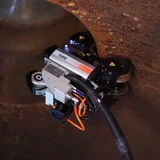Fueling the future of mobility

Can the simplest element of the universe really solve the most complex challenge of our planet ?
Colourless and odourless, hydrogen has never attracted as much attention as now. In pursuit of “ zero emission ”, governments have been investing billions in hydrogen. Our special feature is dedicated to one of its promising app.
Dirty streets, dangerous traffic, polluted air, exhausting noise, rampant infections : transport caused a growing urban pollution problem in the… early 20th century. In fact, 120 years ago, New York, London and Paris were plagued by hundreds of thousands of working horses. Traffic was dense, the noise of metal wheels unbearable, and dust and horse manure caused growing health issues. When “ carriages without horses ” started to appear, it was welcomed as a revolution, a magic solution !

For a while, steam, electric and combustion engines were in com- petition. The latter came to the fore, multiplied exponentially… and now we are paying for the consequences of their nuisances that are much more insidious and dangerous than horse manure : threat- ening health, and a serious threat to humanity. Electric vehicles are back on centre stage.
Today, however, no one believes in a magic solution. Electric vehi- cles don’t emit CO2, but their design presents some issues, and their carbon footprint isn’t neutral. Are there any better solutions ? Here comes hydrogen, labelled “ the energy of the future ” for decades.
Hydrogen vehicles have experienced a strong growth these last few years. Some sources have even mentioned an 80 to 100% increase in H2 vehicles since 2020. Have you seen them running in the streets ? Not really ? It is normal, as the relative figures show the reality of a solution which is still in its infancy.
In fact, there are allegedly only about 60,000 hydrogen vehicles running around the world. It seems like peanuts compared to the 10 million electric vehicles and 67 million vehicles (all categories) sold in 2022. Nine out of ten are running in only four countries (South Korea, USA, China and Japan). Volume production series are limited to two models only : the Hyundai Nexo and the Toyota Mirai repre- sent 98% of sales (Honda abandoned the H2 version of its Clarity in 2021).
Yet, hydrogen vehicles have multiple advantages. Firstly, compared to traditional cars : their fuel cells emit only a little water into the atmosphere, which is great for combatting climate change (and for the health of our lungs). Hydrogen cars also present major assets compared to electric cars : their tank is refilled much faster (a few minutes) and offers twice as much autonomy.
So, what’s holding back demand ? The usual reluctance to embrace such a major innovation. The lack of infrastructure (only a few hun- dred recharging stations around the world !) The high purchase price (around 60,000 dollars, twice as much as some electric cars) is pushed up by high production costs. Hydrogen has made better progress in heavy commercial vehicles (vans, trucks, buses) where the lack of autonomy and the lengthy recharging of electric batter- ies are critical issues.
For the user, the picture is also mixed upstream. As explained by our interviewee (see page 10), current hydrogen production – largely fossil-based – is a problem. And green hydrogen production (by electrolysers) is far from being scalable. For instance, there are a dozen projects of producing hydrogen from wind energy in Europe (H2Mare by Siemens Energy, SEM-REV by Lhyfe…), but they are still “ proof of concept ”.
This could rapidly change. Governments that have set ambitious goals for CO2 reduction cannot go ahead without considering hydrogen. It enables the storage of electricity produced by renew- able energies, replaces part of our heating, which is an enormous source of pollution. Additionally, it can power part of our transport system, currently using 20% of the energy produced worldwide. So, the benefits for the environment are potentially massive. Billions of dollars have been invested, boosting the market. From hydro- gen production to fuel cells, safer, more compact and environmen- tally friendly storage, everything is being studied, rethought and optimised.
In mobility for example, the energy demand of an aerial H 2 long-distance transport network is being evaluated (as presented in a study this summer by MIT). Hydrogen engines are being tested on boats (by technical schools, see page 13) and on heavy-duty land vehicles (tractors in China, Daimler and Volvo trucks).
Cars are not left out either: big brands should soon join Hyundai and Toyota. Honda has announced its comeback on the market with an hydrogen version of its highly popular CR-V for 2024. BMW has been testing a small series of H 2 iX5 and plans its launch between 2025 and 2030. The VW Group has set up a dedicated team at Audi. Kia is planning to adopt fuel cells in the coming years.
Experts are expecting a continuous double-digit growth for hydrogen vehicles. The car market could leap to an estimated 29 billion (1 billion in 2020).
So, yes, we will end up seeing H 2 cars on our streets. For sure, they will be designed and sold as objects of desire. However, we should foremost consider them as our war horses in the Armageddon of climate change.

TOWARDS CARBON-FREE MOBILITY
In mobility for example, the energy demand of an aerial H 2 long-distance transport network is being evaluated (as presented in a study this summer by MIT). Hydrogen engines are being tested on boats (by technical schools, see page 13) and on heavy-duty land vehicles (tractors in China, Daimler and Volvo trucks).
Cars are not left out either: big brands should soon join Hyundai and Toyota. Honda has announced its comeback on the market with an hydrogen version of its highly popular CR-V for 2024. BMW has been testing a small series of H 2 iX5 and plans its launch between 2025 and 2030. The VW Group has set up a dedicated team at Audi. Kia is planning to adopt fuel cells in the coming years.
Experts are expecting a continuous double-digit growth for hydrogen vehicles. The car market could leap to an estimated 29 billion (1 billion in 2020).
So, yes, we will end up seeing H 2 cars on our streets. For sure, they will be designed and sold as objects of desire. However, we should foremost consider them as our war horses in the Armageddon of climate change.


